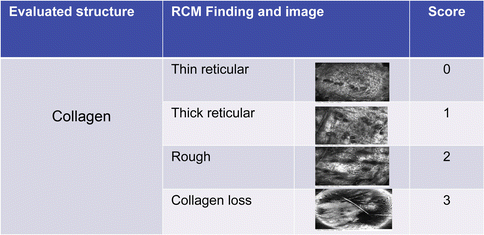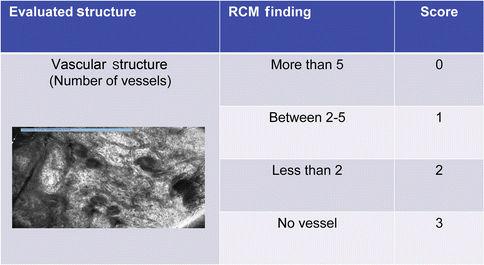Fig. 42.1
Regular and irregular honeycomb appearance, and epidermal loss of the epidermis in images obtained by RCM evaluation, and RCM scores in the different phases of rejection

Fig. 42.2
Appearance of dermal collagen under normal conditions, and in the early and late phases of rejection in RCM images. RCM scores according to signs of rejection

Fig. 42.3
RCM scores according to number of vessels in images obtained with RCM

Fig. 42.4
Ground-glass appearance of skin during acute rejection of the allograft, and RCM scores
All results obtained by RCM were graded, and a scoring system was developed (Table 42.1). Of the parameters evaluated during RCM, epidermal changes, collagen structure, ground-glass appearance, and spongiosis had a high correlation with Banff grade, and this correlation was statistically significant (p < 0.05). Other parameters (i.e., the presence of inflammatory cells and the number of blood vessels) also correlated with the Banff grade; however, these correlations were not statistically significant.
Table 42.1
Reflectance confocal microscopic evaluation scale
Evaluated structure | RCM appearance | Score | Minimum score | Maximum score |
|---|---|---|---|---|
Epidermis | Regular honey comb | 0 | 0 | 2 |
Irregular honey comb | 1 | |||
Epidermal loss | 2 | |||
Circulation | +++ | 0 | 0 | 3 |
++ | 1 | |||
+ | 2 | |||
0 | 3 | |||
Inflammatory cells | Not present | 0 | 0 | 1 |
Present | 1 | |||
Collagen structure | Thin reticular | 0 | 0 | 3 |
Thick reticular | 1 | |||
Rough | 2 | |||
Collagen destruction | 3 | |||
Ground glass, spongiosis | Not present | 0 | 0 | 1 |
Present | 1 | |||
Total | 0 | 10 | ||
The Spearman correlation test was used to determine the correlation between Banff grade and total RCM score, and a statistically significant correlation was observed (correlation coefficient = 0.653; p




Stay updated, free articles. Join our Telegram channel

Full access? Get Clinical Tree








